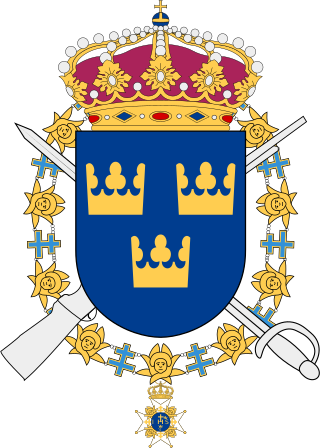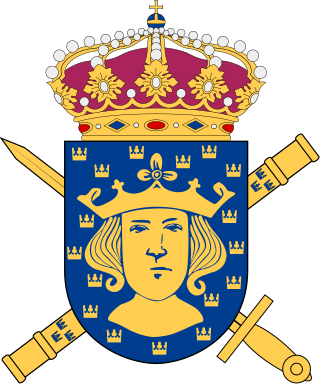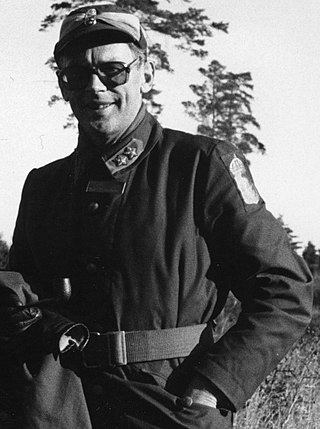
The Life Guards is a combined Swedish Army cavalry/infantry regiment. Its responsibilities include the defence of Stockholm as well as provision of the royal guard of honour for the King of Sweden and the Stockholm Palace. With traditions dating from 1521, the regiment is one of the oldest military units in continuous operational existence in the world. It was established in its present form in July 2000, following a merger of the Svea Life Guards and the Life Guard Dragoons. Headquarters are mainly located in Brunna north of Kungsängen in Upplands-Bro Municipality and at the "Cavalry Barracks 1" in central Stockholm.

The Svea Engineer Corps, designation Ing 1, was a Swedish Army engineer unit that traced its origins back to the 19th century. It was disbanded in 1997. The unit was garrisoned in Uppland and Södermanland.

The Södermanland Regiment, designated P 10 or P 3 and P 10/Fo 43, was an armored regiment of the Swedish Army with its roots in the 17th century, and was located in Strängnäs. The regiment was deactivated in 2004 and its assets were funneled into other parts of the military. Its life company was transferred to the Södermanland Group of the Home Guard, making the Södermanland Group the only Home Guard unit with such a company.

The Life Guard Dragoons, designated K 1, was a Swedish Army cavalry unit active from 1949 to 2000. The unit was formed as a squadron called the Life Guards Squadron (Livgardesskvadronen) in 1949, as a replacement for the previous K 1, the Life Regiment of Horse (1928–1948). In 1975 the squadron were made into a regiment, titled the Life Guard Dragoons with Stockholm Defence District, redesignated the Life Guard Dragoons in 1984. The regiment had ceremonial mounted cavalry duties, as well as training recruits and providing part of the garrison in Stockholm. In accordance with that year's Defence Act, the regiment was amalgamated into the Life Guards in 2000, thus combining the infantry and cavalry guard units of the Swedish Army.
The National CBRN Defence Centre is a Swedish military unit with expertise regarding chemical, biological, radiological and nuclear defense used by both the army, marines and the air force. The unit has been existing in different forms since 1953. Totalförsvarets skyddscentrum is localised together with Västerbottensgruppen within Umeå Garrison, which is the barracks that previously were used by Västerbotten Regiment.

The Eastern Army Division, was a division of the Swedish Army that operated in various forms from 1941 to 2000. Its staff was located in Strängnäs Garrison in Strängnäs. The unit was disbanded as a result of the disarmament policies set forward in the Defence Act of 2000.

The Middle Army Division, was a division of the Swedish Army which operated in various forms from 1941 to 1997. Its staff was located in Linköping Garrison in Linköping.

The Svea Life Guards, also I 1, was a Swedish Army infantry regiment that was active in various forms 1521–2000. The unit was based in the Stockholm Garrison in Stockholm and belonged to the King's Life and Household Troops until 1974.

The Commandant General in Stockholm is a military position in Sweden with responsibility for state ceremonial activities. Lieutenant General Michael Claesson, Chief of Defence Staff is the Commandant General in Stockholm since 2020.
The Defence Act of 2000 was a defence act passed by the Swedish Riksdag on 30 March 2000, and the largest reorganisation of the Swedish Armed Forces since the Defence Act of 1925. The act was a continuation of the policies set in motion by the Defence Act of 1996: shifting the military's focus from the defence of Swedish territory to a more flexible "operational defence* for smaller-scale peacekeeping operations in foreign nations. Many military formations were disbanded as a result.

The Göta Life Guards, designated P 1, was a Swedish Army armoured regiment that was active in various forms 1944–1980. The unit was based in the Enköping Garrison in Enköping and belonged to the King's Life and Household Troops until 1974.
Stockholm Defence District, was a Swedish defence district which operated from 1939 to 2000. Fo 44 was responsible for the defence of Stockholm and its key task was to protect the national Swedish administration, that is, the head of state (king), parliament and the Swedish government.

The Chief of the Defence Staff is the second most senior uniformed member of the Swedish Armed Forces and heads the Defence Staff. The Chief of the Defence Staff is the chief of staff of the Supreme Commander of the Swedish Armed Forces.

The Svea Logistic Corps was a Swedish Army logistic corps operating between 1891 and 1997. The unit was based in Linköping.

Lieutenant General Nils Gustaf Axel Welin was a senior Swedish Army officer. Welin served as head of the Swedish National Defence College (1984–1987), as Force Commander of the United Nations Disengagement Observer Force (UNDOF) (1986–1988) and as Commanding General of the Southern Military District (1988–1992).
The Southern Military Region is a Swedish military region within the Swedish Armed Forces. Established in 2013, the military region staff in based in Revingeby. The military region includes Skåne County, Blekinge County, Kronoberg County, Jönköping County, Kalmar County and Östergötland County.
Major General Nils Fredrik Adam Ståhlberg is a Swedish Army officer. He currently serves as the Deputy Chief of Joint Operations from 1 January 2023. Prior to that, Ståhlberg served as commanding officer of the Western Military Region (2013–2017), as Chief of the Land Component Command (2017–2018), as Deputy Chief of Army (2017–2020), as Deputy Vice Chancellor of the Swedish Defence University from 2020 to 2022 and as Deputy Director of Human Resources in 2021.
Carl Nils Stefan Sandborg né Johansson is a senior Swedish Army officer. He served as the Chief of Home Guard from 2018 to 2022.
The Director of Communication and Public Affairs is the director of communications of the Swedish Armed Forces, in charge of public affairs. KOMDIR, which heads the Communications Department (Ledningsstabens kommunikationsavdelning, LEDS KOMM, previously called the Office of Communication and Public Affairs, is an administrative position based at the Swedish Armed Forces Headquarters in Stockholm. The KOMDIR is part of the Defence Board, a group of the Supreme Commander's top commanders.

Major General Dan Jonny Mattias Lindfors is a Swedish Army officer. Lindfors has served as commander of the Kings Guards Battalion in the Life Guards, of Norrbotten Regiment, and as Assistant Chief of Armed Forces Training & Procurement. He assumed the position of Chief of Army on 18 June 2023.














